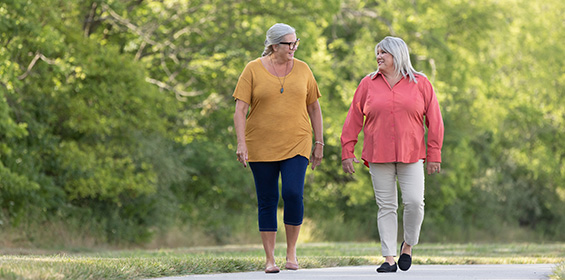Getting started with a fitness routine can be challenging for anyone, but if you’re living with arthritis, it can seem like a daunting task. The good news is that no matter your age, skill level or stage of arthritis, there’s a way to incorporate movement into your life. Read on to learn why exercise is important for someone living with arthritis, how to get started with an exercise routine and the difference between good and bad pain.
Benefits of Exercise for Arthritis
Improves Joint Health
Walking and other low-impact exercises increase blood flow, which is vital for joint health. As an example, think about an older car’s carburetor and fuel filter – sometimes you need to give it some gas and clear things out. Same can be said about moving your body – when you move your body, it gets your blood flowing and benefits everything from your muscles to digestive system and kidneys. Improved circulation helps deliver nutrients and remove waste products from your joints.
Mobilizes Hyaluronic Acid
Exercise helps mobilize hyaluronic acid, which is essential for maintaining the health of your meniscus and cartilage. This substance, which your body produces naturally, acts as a lubricant and shock absorber in your joints.
Strengthens Muscles
Increased strength from regular exercise shifts pressure away from your joints and onto your muscles. Stronger muscles support and stabilize your joints, reducing the risk of pain and injury.
Tips for Getting Started With an Arthritis-Friendly Exercise Routine
Regular movement is essential for joint health and overall fitness as it helps maintain flexibility and strengthens muscles, reducing pressure on joints. Therefore, movement is beneficial for anyone managing arthritis, but it’s important to note that an exercise routine is not one-size-fits-all. Everyone experiences arthritis symptoms differently and has unique goals.
Start Small
Everyone has to start somewhere, so don’t be discouraged by starting with short, light sessions. Even a brief walk, like to and from the mailbox a few times, can be a big step toward better health.
Progress Gradually
Start with very light activities to assess how your body responds. Increase your intensity and duration slowly. For example, if you usually take three laps around the neighborhood, see how your body feels after five laps. This slow progression helps prevent overloading your joints.
Eat a Balanced Diet
Arthritis simply means inflammation of the joint. While there’s certain refined sugars that we love to have in our diet, it’s statically shown that those sugars increase inflammation in our bodies. For someone with arthritis who already has inflammation in their joints, it’s important to limit refined sugar and instead focus on inflammation-fighting foods. The Arthritis Foundation offers numerous helpful resources to guide you in making healthy choices. You can explore them at arthritis.org/health-wellness/detail?content=healthyliving.
Remember to Stretch
Stretching can help improve arthritis pain and improve joint function, enhance mobility, prevent injury, increase flexibility and reduce muscle soreness. There are many stretches you can do daily and essentially anywhere, including the gastroc stretch on a wall, standing hamstring stretch on a chair, supine piriformis stretch and seated trunk rotation stretch – click to see demonstrations and learn more.
Overall, consistency is key. Your body benefits from regular movement and finding an activity you enjoy encourages you to stick with a routine, leading to the best results over time.
Understanding Good vs. Bad Pain
Good Pain
Muscle soreness after a workout is common and usually means your muscles are adapting and strengthening. This discomfort typically resolves within one to two days. To relieve soreness, try a lighter version of the previous day’s activity instead of not moving at all. For example, if you’re sore from walking five blocks yesterday, try walking two or three blocks today to help ease the soreness.
Bad Pain
Joint pain or abnormal soreness could indicate overexertion or an underlying issue. Consider modifying your routine or reassessing your activity level if you experience sharp/persistent pain, pain while resting or if your soreness doesn’t improve with rest.
When to See a Doctor
See a doctor if you have persistent joint pain that doesn’t improve with rest, difficulty straightening the knee, noticeable asymmetry in your leg or a limp. These symptoms can be common with arthritis, but could also indicate an injury, joint misalignment or muscle weakness that need evaluation and treatment.
Arthritis doesn’t have to be a barrier to being active. With the right approach and support, you can start and maintain a fitness routine that works for you. Remember to start slow, choose exercises that are gentle on your joints – like walking, swimming, cycling or yoga – and pay attention to how your body feels. Most importantly, find an activity that you love to remain motivated and keep activities consistent. Don’t let arthritis hold you back, start moving and embrace a healthier lifestyle – your joints will thank you!
To schedule an appointment with Central Indiana Orthopedics, call 800-622-6575 or request one online at ciocenter.com/contact-us/.

